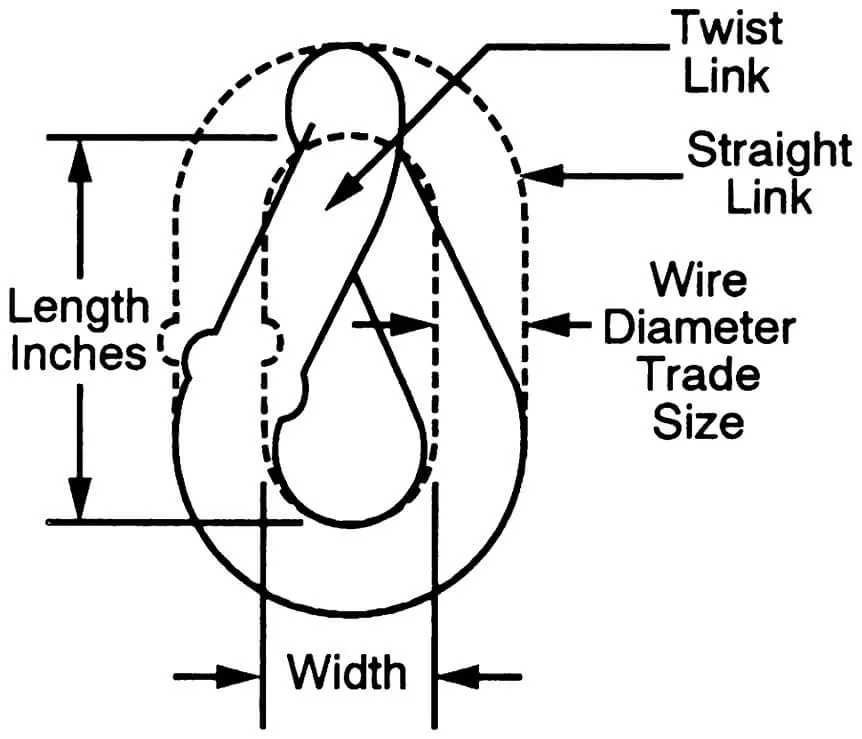Carbon Chain
Carbon Chain
Definitions & Warnings
Chain Definitions
The Low Carbon chains and attachments shown in this catalog are designed for general purpose applications and are not to be used for lifting or hoisting purposes or where chain failure is likely to cause injury to persons or damage to property.
For lifting or hoisting applications, chain and attachments should be used.

Working Load Limit: The “working load limit” is the maximum load in pounds which at any time or under any condition should ever be applied to chain or a sling component, even when chain is new and in the same condition it was when it left the factory, and when the load is evenly applied in direct tension to a straight length of chain.
The following factors or abuses will lessen the load that the chain assembly will withstand and should be avoided:
- Tip loading of hooks
- Twisting of the chain
- Disfigurement
- Deterioration of chain or component by wear, usage or corrosion
- Jerking or the sudden impact of a load multiplies the stress on the chain very rapidly
- Use other than that for which the chain or component was intended
Caution: Chain and component assemblies should be rated according to the working load limit of the weakest component.
Instructions Regarding Attachments: Care should be taken to select attachments of the same type, grade, size and working load limit as the chain. Follow recommended attachment procedure for best results.
Misuse or abuse of chain and attachments may result in serious personal injury.
All dimensions shown are nominal and all weights are approximate. See individual pages for working load limits.
Definitions and Warnings
Columbus McKinnon Corporation assumes no responsibility for the use or misapplication of any of its products. Products are provided with the express understanding that the purchaser and/or user are thoroughly familiar with the correct application and proper use. The following warnings and definitions are provided as an aid to understanding.
The chains listed on the pages in this catalog exceed the specifications of the National Association of Chain Manufacturers for the specific types of chain involved. However, none of these chains are made from alloy steel
and should not be used for overhead lifting purposes. CM Chain produces an alloy chain known as Herc-Alloy 800 chain that is designed for overhead lifting.
Definitions
Working Load Limit — Refers to the maximum load (rated capacity) in pounds that shall be applied in direct tension to a straight length of chain or attachment. The working load limit shall not be exceeded.
Proof Test (or Manufacturing Test Force) — Refers to a load in pounds which an attachment or chain (or both) has withstood during a test in which an increasing tension is applied to an attachment or straight length of chain. This is typically accomplished as part of the manufacturing or testing process.
Minimum Break Load — Refers to a load in pounds as applied to an attachment or chain at the time itleft the factory that has been found by representative testing to break the item under test of increasing force
as applied by a standard testing machine. This a manufacturing test and such data is not intended for service or design purposes.
Warnings
Never exceed the “working load limit” of chain or attachments, even when the item is new and the load is uniformly applied.
Before use, always inspect chain and attachments for kinking, twisting, knotting, and visible defects such as distortion or damage.
Do not jerk load. Pick up slowly and apply a steady pull.
Protect items from corrosion. Any product will break if abused or overused.
Use only alloy chain attachments (Grade 80) for overhead lifting purposes, never any other chain.
The terms “working load limit,” “proof test,” and “minimum break load” contain no implication of what load an attachment or chain will withstand, if any, if the factors noted in the Definitions are changed.
The “working load limit” should not be exceeded, even when an attachment or chain is new and the load is uniformly applied. The manufacturer does not accept any liability for damages with result from an attachment or chain being used in excess of the working load limit.
Any changes in these factors could lessen the load the chain will hold. For example:
- Acceleration in the rate of application, which could cause dangerous overloading.
- Variation in the angle of the load. As the angle or inclination decreases, the working load capacity of a sling will decrease accordingly.
- Twisting, knotting and kinking.
- A purpose other than that for which the chain was intended.
Where attachments, such as hooks or rings are desired for use with chain in sustaining loads, care should be taken to select attachments of the type, grade, and size recommended for use with corresponding alloy chain with which such attachments are used.
WARNING:
Failure to read, understand and follow these instructions and working load limits may cause serious physical injury and property damage.
